#nano sponge
Explore tagged Tumblr posts
Text
Nano Sponges Contain Formaldehyde Contamination?
Kitchen grease cleaning has always been a headache, and traditional cleaning sponges often need to be used with chemical cleaning agents, making cleaning stubborn stains time-consuming and laborious. In recent years, the new nano sponge has become popular because it is ideal for cleaning stubborn stains and does not require any chemical cleaning agents. So where does the cleaning superpower of the nano sponge come from?
A discreet and introverted "techie".
Nano sponges are known by the scientific name melamine foam, commonly known as magic wipe, high-tech sponge and so on. The main component of the nano sponge is a melamine resin foam, made from melamine and formaldehyde polymerisation. The melamine resin has a high porosity three-dimensional mesh structure, each "bubble hole" has at least 3 holes or 2 destructive surfaces, and most of the bubble prongs are shared by at least 3 structural units. The capillary openings in the sponge automatically absorb stains from the surface during the wiping process. Because of its comprehensive properties such as good sound absorption, flame retardancy and resistance to humidity and heat, nano sponges are widely used in the construction industry, electronic products, biological treatment processes and other fields. The nano sponge is also a good helper in household chores, with high grease removal capacity and high water efficiency (only 30-40% of the water used in traditional cleaning methods), making it a highly acclaimed cleaning tool.
Rumoured to be toxic?
While melamine and formaldehyde are both toxic chemicals when singled out, the synthetic amine resin is a stable substance that does not decompose into formaldehyde again. However, during the polymerisation of the two molecules, some of the unreacted free formaldehyde is present in the nano sponge. Therefore, manufacturers reduce the free formaldehyde content by improving the foaming process and maturing the formaldehyde removal process. In addition, formaldehyde itself is a water-soluble and chemically unstable substance and can be removed by placing it in a ventilated area or rinsing with water before use. If you buy a nano sponge from a qualified merchant, ventilate it for a period of time, rinse it and then use it, you can basically avoid the danger of formaldehyde!
Tips:
From a hygiene point of view, the spaces between the sponges can accumulate a lot of grease and food residue, which should be rinsed and dried after use.
Do not use the nano sponge on electrical products that are not suitable for contact with water.
Do not use bleach or hot water to disinfect the sponge as this will cause the sponge to yellow and deteriorate and will shorten its life.
More information or free samples or price quotations, please contact us via email: [email protected] , or voice to us at: +86-28-8411-1861.

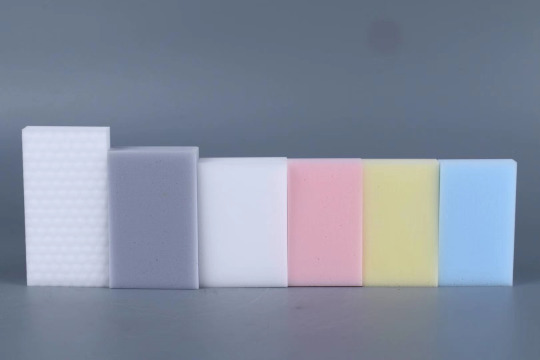
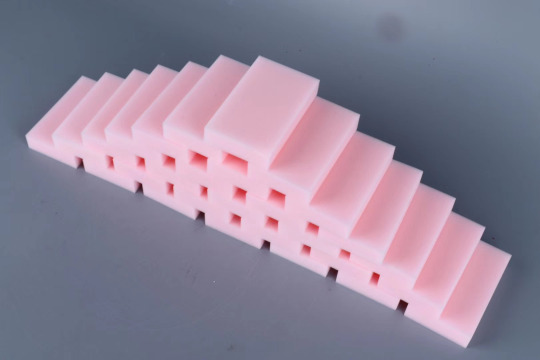
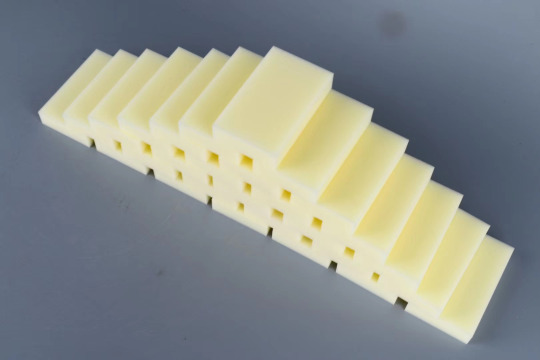
2 notes
·
View notes
Text
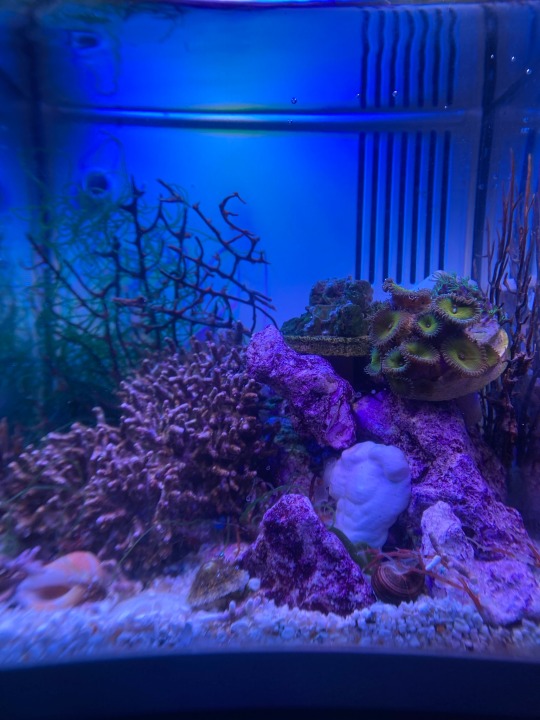

finally broke down and obtained some corals for my little micro reef… the palythoas opened up almost IMMEDIATELY which i’m still sooo stoked about, and the GSPs followed suit not long after!! the zoanthids (the frag further back) are a bit more shy but i took another timelapse of them and i could see the polyps pulsing and shifting so they’re still alive, just taking a little bit longer to settle in. i’m very happy with them and i hope they thrive!!!
#i’ve got more on the way already 😭 just a little bitty pulsing xenia frag#and a yellow ball sponge#7g floating nano reef
23 notes
·
View notes
Note
MOD MY FRIEND IS GETTING SHRAMPS THEY ARE MAKING A SHRAMP HAVEN (NOW /REF) IN THEIR BIG TANK THEY FOUND AND THEY WANNA MAKE IT A NO-FILTER ECOSYSTEM W GOOD PLANTS AND STUFF AND MAYBE SOME NEON TETRAS WHAT ARE UR THONKS AND ADVICE O GREAT FISHY ONE, BEARER OR CHILD AND SHRAMP KNOWLEDGE
OHHHHHH!!!!!!!
hang on though. revealing my shame. I've tried to start a shrimp colony 3 times and every time they REFUSE to breed and eventually die off.... once i have a little extra money for shramp i have a well established 5g I'll try ONE MORE TIME ON cuz i do love watching those little buggy guys...... so I'm not a shrimp guru 😔
BUT I WILL ADVISE. I've had neons and obvs I'm a planted tank freak :3
neons are tough cuz they actually get bigger than you think, i started with like 8 in a 10g with my very first tank and once they got fully grown they definitely didn't have enough room, I'm now like ok if you're gonna get neons or similar sized schooling fish you should get as many as possible (like 12-15 minimum) and in no smaller than a 20g long. i stand by that. if your friend wants a little schooling fish they should instead look at nano rasbora species!! i had 10 strawberry rasboras in my 5g and it was great (bigger is always better but these fish are sooo small they were ok). chilis and phoenix rasboras are also great. you could fit a bunch in a 10g no problem!!!
now with general tank stuff. i recommend starting with a sponge filter before trying to go no filter, because no filter needs a lot of time for plants and bacteria to establish before it'll work well. but the best place if you're aiming for no filter are floating plants and fast growing stem or runner plants. for floaters i like salvinia (avoid duckweed if possible but it'll probably manifest anyway, at which point just resign yourself to it lol), for stems i like rotala or cabomba (you can constantly trim and replant, self generating plants!), and for runners i like vallisineria (looks like grass and is always visually gorgeous). for the absolute end all easiest plant experience, throw in some guppy grass. no planting required just throw it in. it'll grow like crazy into big lush bunches. ultimate easy plant.
the longer you just let the tank go establishing itself before adding the shrimp, the better chance they have. then when adding them, you wanna add as many as possible at the jump, like 10 at least. it's also best (and usually cheapest) to see if a hobbyist is selling shrimp on local markets. that way you know they've been bred in hopefully your same quality of tap water, so transition should be easier.
WISH YOUR FRIEND THE BEST OF LUCK ON THEIR SHREST (shrimp quest)
#fish tag#now i have some fat awesome years old amanos but that's different from a lil cherry shrimp colony lol#m2a#m2answers#fishblr
13 notes
·
View notes
Note
As an aficionado of aquatic snails can I ask your reccomendation as to a good choice of aquatic snail for a large community tank housing a golden pearl (?) gourami, a bonded pair of angelfish, a male and female pair of spotted silver dollars, 6 glass catfish, 5 banded Kuhli loach, 3 Cory catfish (one male peppered, 1 julii leopard of currently undetermined sex and a truly ancient female albino) and a school of tetras (mostly glolite with 2 older rummy noses and 2 even older cardinals).
The tank is freshwater and kept to 26°C, 2 nano airstones one either side of the tank, multiple hiding places and it’s planted out with live blue stricta (chosen because they grow faster than the silver dollars can eat them…)
Tank also has a canister filter I’ve set up with two different ppm sponges for mechanical filtration, ceramic noodles for biological filtration and a mix of bituminous carbon, zeolite and Seachem Phosguard as chemical filtration.
Ideally I’d be looking for something that won’t breed like it’s trying to create an army for world domination and would be happy to aid in algae and food scraps/waste cleanup.
I’ve kept mystery snails before and years ago attempted bladder snails (😰 NEVER AGAIN) but there’s so many snails to choose from it can be overwhelming and you seem to know your snails so I’d trust your reccomendation more than my guessing. I’ve also kept shrimp before as cleanup crew but I just know in this tank they’d be lunch in no time.
My personal favorite is rabbit snails because they’re so silly looking and they only have one baby at a time, so they reproduce very slowly. Nerites are great algae-eaters and they’re very low-maintenance, and come in a lot of cool shell patterns and colors. Those are my two go-tos for omnivorous aquarium snails because they’re so cute and fairly easy to take care of. Apple snails are also very neat but they get gigantic and breed fairly quickly so they might present some challenges. I’ve never personally owned ramshorn snails but apparently they make amazing clean-up crews and are very pretty but they are definitely fast multipliers so they may not be great if you’re not into that.
16 notes
·
View notes
Text
What toothpaste works really well to fix dull headlights?
Using toothpaste to fix dim headlights is an inexpensive and well-known temporary method, but its effectiveness and durability depend on the degree of oxidation and the method of operation. Here is a detailed guide:
✅ Applicable scenarios
Mild surface oxidation (foggy whitening, fine lines).
Emergency treatment (such as temporary brightening before annual inspection).
❌ Ineffective situations
Deep oxidation/cracking (yellowing inside the light shield).
Physical damage (scratches penetrating the surface).
🔧 Best toothpaste type Ingredients Recommended brand/type Principle Contains baking soda Colgate Total (containing microcrystalline calcium carbonate) Abrasive particles (RDA value > 100) remove oxide layer Contains silica Crest Whitening Toothpaste Polishing agent improves surface smoothness High abrasive type Arm & Hammer Advanced Baking soda + phosphate enhances cleaning power
Avoid using: gel toothpaste (such as Oral-B PRO-HEALTH, insufficient abrasive) or children's toothpaste (RDA value is too low).
📝 Operation steps
Clean the surface: Wash the headlights with soapy water and dry them.
Apply toothpaste: Take a 1 yuan coin-sized amount of toothpaste and apply it evenly on the headlights.
Polishing:
Manual: Polish in concentric circles with a microfiber cloth for 5–8 minutes (with even pressure).
Mechanical (recommended): Use a handheld electric drill + sponge polishing disc (speed <1,500 RPM).
Rinse and check: Rinse with clean water, wipe dry and check for light transmittance.
Sealing protection: Apply UV-curing sealant (such as 3M 39173) to extend the effect.
📊 Effect comparison Method Transmittance improvement Durability Cost Toothpaste polishing 20%–40% 1–3 months ¥5–20 Professional repair kit 60%–80% 6–12 months ¥100–300 Replacement of lampshade assembly 95%+ 5 years+ ¥500–2,000
⚠️ Precautions
Risk of over-polishing: Frequent use of toothpaste will thin the polycarbonate layer, causing the light-transmitting cover to be brittle and easy to crack.
UV protection: UV sealant must be applied after repair, otherwise it will re-oxidize within 3 weeks.
Compatibility: This method is prohibited for headlights with coating (such as Mercedes-Benz Multibeam) as it will damage the coating.
💡 Upgrade Solution If toothpaste is not effective enough, you can try:
3-step repair kit:
Wet sandpaper (800→1500→3000 mesh).
Oxide layer remover (containing dichloromethane).
UV curing liquid (such as Meguiar's G3000).
Nano coating spray (such as Cerakote 60400), UV-resistant and long-lasting.
Summary: Toothpaste containing baking soda or silica can be used as a quick repair solution for mild oxidation, but it needs to be used with sealants and its limitations are understood. For severely aged headlights, it is recommended to invest in professional repair or replacement of the assembly to ensure driving safety.

#led lights#car lights#led car light#youtube#led auto light#led headlights#led light#led headlight bulbs#ledlighting#young artist#car#cars#SUV#car light#headlight#headlights#headlamp#headlamps#car lamp#lamp#lights#led light bulbs#repair kit#repair#fix dull headlights#car culture#coupe#chevrolet#convertible#supercar
2 notes
·
View notes
Text
🐌 What Is a Mystery Snail?
Mystery Snails (Pomacea bridgesii) are peaceful, algae-eating freshwater snails native to South America. They're highly popular in home aquariums for their wide range of vibrant shell colors, gentle temperament, and usefulness in tank cleanup. Unlike pest snails, they do not breed uncontrollably and are easy to manage in most setups.
🎨 Color Variants
Mystery Snails are available in a variety of beautiful shell colors, including:
🟡 Gold Mystery Snail
⚪ Ivory White Mystery Snail
🔵 Blue Mystery Snail
⚫ Black Mystery Snail
🟣 Purple Mystery Snail
🐌 Jade, Magenta, and Chestnut (rarer colors)
Each snail has a unique foot color that may contrast or match the shell, making them visually striking additions to planted tanks or nano aquariums.
💧 Ideal Tank Conditions
ParameterRangeTemperature70–80°F (21–27°C)pH7.0–8.0 (alkaline preferred)HardnessModerate to high (for healthy shells)Tank Size5 gallons minimum (per snail)SubstrateSand or smooth gravelFiltrationGentle flow; sponge filters are safe
🍽️ Diet and Feeding
Mystery Snails are omnivores:
Algae (glass, plants, rocks)
Leftover fish food
Blanched vegetables (zucchini, spinach)
Calcium supplements (cuttlebone, shrimp pellets) to prevent shell erosion
They graze constantly and help clean the tank, but should be supplemented if algae is insufficient.
🤝 Temperament and Compatibility
Peaceful and non-aggressive
Safe with shrimp, peaceful fish, and other snails
Avoid housing with loaches or aggressive species that may nip at their antennae
🧬 Reproduction
Sexual reproducers (need a male and female)
Lay pink egg clutches above the waterline
Eggs can be removed if breeding is not desired
No asexual reproduction = no overpopulation problem
📏 Size and Lifespan
Size: Up to 2 inches (5 cm) in diameter
Lifespan: 1–2 years on average, longer with excellent care
✅ What Makes Mystery Snails Great?
Bright colors enhance aquascapes
Excellent algae eaters and tank cleaners
Easy to care for – perfect for beginners
Don't overbreed like pest snails
Fascinating to watch as they glide across the tank
2 notes
·
View notes
Text

@minkandstink
More than anything else, fish stores are looking for these qualities:
Taking initiative. It's better to do something and do it wrong, than it is to not do anything. In the fish keeping hobby, a lot more can go wrong if you do nothing because you're afraid of accidents.
Information sponging. If you find aquariums and fish and all that stuff extremely interesting (more than that, if you're autistic or otherwise neurodivergent about aquariums or marine/aquatic life), you're probably able to absorb and retain MUCH more information related to the hobby than other people. You'll be able to relay that information to others much more easily as well. Even if you don't know very much, but you're incredibly willing to learn, they LOVE that. Probably don't mention autism on the resume though. That's not me being internally ableist, that's me trying to say there are legal loopholes you shouldn't risk until your position is safe.
Physical strength, sometimes. Occasionally, part of the job may include carrying water here and there. Buckets, jugs, whatever. Usually it's not more than 5 gallons at a time, but you might have to move a lot of water overall. 5 gallons of water is roughly 40lbs. If you're incapable of carrying at least 15lbs by yourself, be sure to clarify that. They don't usually mind if you can't, as long as they have someone who can, or a cart to load things on.
Pattern recognition. Being able to recognize different species of fish, species of coral, species of plants, genders of fish etc. You should be able to subvert the expectation that the average person won't know the minimum care requirements. Trust me, I meet a lot of people working here, and it's SHOCKING when someone knows the comfortable minimums for care.
Fearlessness, creative thinking & problem solving. Being able to think quickly and come up with unique (but good!) solutions to problems in the hobby, with maintenance, or the technical/mechanical side of things is important. You might have to emergency-DIY a lid for a tank with a fish that insists on jumping to their death, or you might have to quickly patch a leak on something. You might have to stick your hands into dirty, gross filter shit and not be scared of it. Be prepared to smell things you don't like, and be even more prepared to see beautiful and cute fish die, especially at the hands of irresponsible owners, BUT ALSO at the store in the display tanks! It happens often, and sometimes there's nothing you can do.
Being really, REALLY prepared to deal with incredibly ornery people that don't like being told what to do. It's classic retail. People will argue with you, people will bring their young children who scream and beg for a fish, so the parents can't say no without causing a scene (and they know it). People won't understand why things are different now compared to 20 years ago when they "just had a fish in a bowl and it was fine", and people will walk out on you to go to Petco or Petsmart instead, leaving a bad review online because they didn't want to wait for their nitrifying bacteria to establish before adding the fish they're so desperately impatient for. It's bad, and it gets worse, and people can be inexperienced to SUCH a ridiculous degree that you'd think they're just flat out stupid. Patience is incredibly important. If you have previous experience in ANY amount of customer service & working a register, they'll appreciate that a lot.
Finally, Your own experience in the hobby, fish or not. Fish stores like applicants that have their own aquariums at home, even if they're small and seemingly insignificant. You might think that a tiny little snail/shrimp aquarium isn't impressive, but it's the opposite! I'm always, always impressed to hear someone talk about their nano/pico tank being established and thriving, because those tanks are actually the hardest to maintain long-term. They're much more work and dedication. Fish stores also appreciate any experience with non-aquatic exotics. If you have reptiles, birds, or anything other than a dog or cat, and you can confidently say you've had them thriving for a long time, they'll hear that someone understands the needs of a more complicated type of pet, and is capable of learning or knowing more.
It should also be important to scope out the place before applying! Shop around, interact with your potential coworkers, get a feel for their vibes and see if you'd get along with them well enough in a work environment. If they like you before you even apply, you've got better chances! Even if you have to fake it, for the most part.
I will say, I cheated the system. They hired me because they only had one woman on staff and I, conveniently, am a woman with extensive foodservice experience and neon green hair. They didn't even interview me. They called me 2 weeks later asking when I can start just because I'm a woman with colorful hair. So.
Also... unethical life hack, it's okay to lie a little on your resume. Embellish your life experiences and emphasize how much you're willing to learn about the things you don't know.
THINGS TO KEEP IN MIND:
Some regions may allow large retailers like Petsmart and Petco (though not limited to these two) to have non-compete clauses in their employment agreement. What this means is, if you signed a contract with them, you may not be legally allowed to work for any businesses that compete with them, at least during your employment.
It's no longer legal for employers to enforce this on their employees POST-employment in the United States as of April 2024, but in other countries this might not be the case; meaning that outside the USA, if you choose to sign a non-compete clause to be employed at Petsmart (or some other large pet retailer), it may be several years post-employment before you're legally allowed to work for any businesses that financially compete with your previous employer.
But in the USA for example, if you have a job with Petco, you may not be allowed to simultaneously have a job at a local fish store due to a non-compete clause in your employment contract. Essentially, don't plan on being part-time with Petco and part-time with a local business. It probably isn't going to work out.
If you have any more questions feel free to ask!
I'm here all day <3 I love this part of my job lol
4 notes
·
View notes
Text
small bootleg!tmnt details/fun facts
from what i've seen nobody ever pointed them out so i thought it'd be nice to share ^^ spoilers ahead ofc
in 'who needs a vet', the stockman's remedy is actually a large contributor to the boys' recovery as the recipe was developed by superfly to aid his family/mutants
the intervention gag in 'sports! any%' and 'leon ardo alone' is inspired by the same gag in How I Met Your Mother
in 'pizza-nal economics', the only reason why leroy hired mikey (and by extension, keno) is because he knew he could fight/defend himself from the customers of their business
according to the boys' pizza tier list, Run of the Mill is an A tier
Raph-Bucks were inspired by the unicon bits from the las pegasus unicon incident
the episode's ending with mikey walking in to the raph-buck revolution is also inspired by the community pizza fire meme
as mentioned by casey in 'i thought YOU were sneaking out', raph had technically met them during his sports speedrun, as they were the goalie raph hit in the shin
bishop is actually teased as early as the episode 'fiend trip' by the principal
melissa is very heavily inspired by old friends of mine which is why she's Like That lmao
i mutated the general into scale tail for the sake of using the concept design before the mutant mayhem script released and revealed that his name is actually spider... oops–
lotus's background wasn't actually planned and was made during her introduction in 'leon ardo alone', the reason being is because i didn't want to actually make her last name blossom
the reason why klunk duplicates is due to the sea sponge dna she mutated with, as some sea sponges can create extensions of themselves if they feel like they are in danger
by extension, when klunk is scared, she hardens for defense, but when she's happy/relaxed, her entire body softens, including her organs
the person bishop is calling throughout 'green party candidates' and briefly in 'the devolution of turtle' is irma's mother, mrs. lynette knight, though they are close enough for first name basis
as explained in 'no paint no gain', keno is well liked by/has easy entry to the crime scene of nyc due to his cousin being in the foot clan
although not explored in season 1, angel has a heavy interest in film and has implemented tv systems in each room of hun's house
leo told bishop about the market incident, as he mentioned to casey in 'no paint no gain', which is why tcri (and eventually hun) knows about casey's involvement and relationship with the turtles
i did not know about the 03 nano episodes in depth before writing marion into donnie's tech circle and for that i am so sorry
in 'the psat', irma is supposed to act as the proper example of how to treat the psats: completely unseriously
i didn't know normani announced her album around the time of 'the psat' episode's release until a month after
'the devolution of turtle' was genuinely gonna be a lot more of a sillier episode but it really took a turn after bishop started being developed
the mutants in the cages is basically a gateway implementation for mutants introduced in canon tottmnt when it comes out
the reason the turtles turtle-piled in 'is mutant a heritage' is because it became a coping mechanism for them after the previous episode
and last but not least for the finale (and spoiler tidbit for s2):
miwa
7 notes
·
View notes
Text
My Contest Aquarium from "The Art of the Planted Aquarium" - the largest Live Aquascaping Contest in Europe
The wood in the 35L Dennerle tank have coloured the water due to their humic substances. This is also clearly visible on the back wall, which is actually white.
However, this becomes less and less from time to time and water changes help a lot. 😁
Incidentally, I replaced the Dennerle corner filter with an Aquael Versamax Mini Hang-On filter. Simply so that there is more space in the tank and unfortunately I don't have room for an external filter here.
The filter is currently filled with filter wool and sponge. Depending on how this fits into the filter, as it is very small, I will add some Seachem Purigen to make the water even clearer.
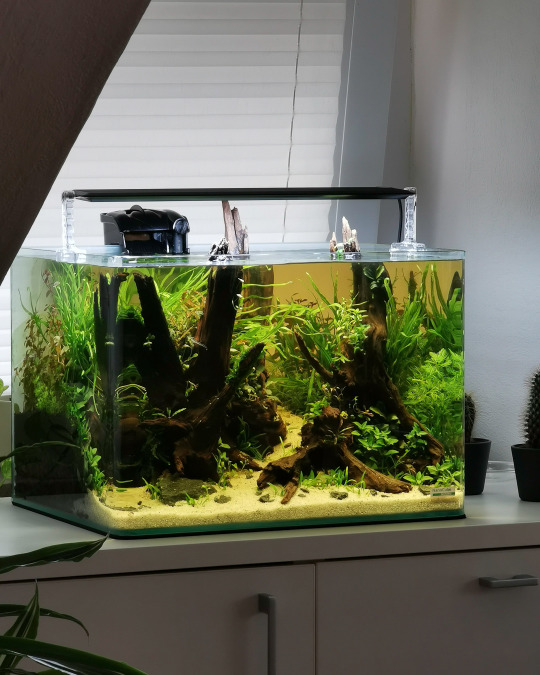
Aquarium: Dennerle Nano Tank Plant Pro 35L
Filter: Aquael Versamax Mini
Lighting: Chihiros A II 401
Hardscape: Ikebana Wood & Titan Stones
Substrate: JBL Volcano Mineral, Plant Soil & Sansibar River Sand
For more content, behind the scenes and full setup videos don't forget to follow my Instagram and YouTube channel.
7 notes
·
View notes
Text
Is Nano Sponge (Melamine Foam) Harmful to the Human Body when Used for Cleaning?
Nano sponge is also called cleaning sponge\magic sponge\magic wipe, and the technical term is Melamine Foam. It is very effective for cleaning household stainless steel products, bathroom products, glass products, tiles and porcelain, leather sofas, cars, tables and chairs, wooden floors and other things. When cleaning, you only need to use water to quickly remove stains, so it is quickly familiar to everyone.
However, there are reports that the raw material of nano sponge is melamine. Will this be harmful to the human body? The main reason why people have doubts is the impact of the melamine-tainted milk powder incident.
Compared with melamine, more and more people are paying attention to the formaldehyde release of magic wipes. Here we will explain it to you in detail.

1. According to the "Hygienic Standards for Formaldehyde in Bedroom Air", the maximum allowable concentration of formaldehyde in bedroom air is 0.08 mg/cubic meter. Put the nano sponge into a large closed beaker to measure the formaldehyde concentration. According to this measurement method, all the home decoration materials placed in it will probably exceed the standard. It should be noted that the formaldehyde concentration measured is the formaldehyde concentration in the indoor air, not the formaldehyde concentration measured by placing purchased decorations in a small sealed box.
2. Formaldehyde is a substance that is easily soluble in water and chemically unstable. It dissipates before it can be enriched. Compared with the convenience brought by nano sponge and the disadvantages of many cleaning tools before it (nano sponge is not easy to get moldy, people who have used it should have noticed that stainless steel wire is more harmful to tableware. Ordinary sponges are very susceptible to mold growth, and ordinary rags are even more fungus-centered).
3. When melamine resin is used as tableware, the country actually issued relevant standards as early as 1980. This standard has been revised twice and is currently GB9690-2009, which has requirements for the migration amount of formaldehyde. Although tableware and nano-sponge are different, they are both melamine and kitchen supplies. Before the national standard of nano-sponge is released, they can also be used for reference. According to this standard, it is determined whether the nano sponge meets the standard, instead of simply saying that it is unqualified if it releases formaldehyde. There are many things containing formaldehyde. As for the consequences, it is still subject to not exceeding the standard.
Where does the Nano Sponge’s excellent cleaning ability come from?
Due to its high hardness and brittleness, melamine-formaldehyde resin foam is brittle and can separate from the foam surface through friction and disperse into fine particles. When wiping stains, these fine particles shed from the foam surface form effective friction with stubborn stains, wiping the stains off and effectively adsorbing them into the pores of the foam. Therefore, this resin foam dry wipe also has great cleaning capabilities.
Melamine formaldehyde resin foam has an open three-dimensional network porous structure, and the cell structure is thin and good. These tiny porous network structures easily absorb moisture and show hydrophilicity, so the adsorption performance is excellent. The excellent adsorption performance of this microporous structure also has a good cleaning effect on stains on scratches on the surface of objects.
Moreover, the nano sponge itself has good physical stability, does not melt in water, and is fireproof.
More information or free samples or price quotations, please contact us via email: [email protected] , or voice to us at: +86-28-8411-1861.
0 notes
Text
"Chinese scientists have created some experimental sponges out of starch and gelatin that can soak up microplastics which could be adopted in various places to reduce plastic pollution from entering the oceans.
The sponges are literally as light as a feather, and inside their pores, not only microplastics, but nanoplastic particles of less than one micron in size—or 1 millionth of a meter—can become trapped."
10 notes
·
View notes
Text
[sponsored]
I've probably said too much already. No doubt there are some, such as Elmer Olden Burke, who would try to drown a fellow in a puddle for exposing such a marvelous truth about the electric plastic sponge mop. I’m not saying that it was developed using alien technology obtained in a barter program for the bodies of 15 month old babies which are considered delicacies among the discerning inhabitants of the Dog Star, but I will guarantee that it will be a boon to you, your housekeeper, or your babysitter, and it may even be beneficial to all dudes' ceaseless quest to seduce the hottest of ladies by having a sparkling pad for them to perhaps spend the night in carnal enjoyment within. No one can say for sure how vast this and many other benefits will be in unlocking the hidden vibrational frequencies in your closet or lurking among your linens, but I think it’s safe to say that whoever tries the electric plastic sponge mop will find that it is the finest electric plastic sponge mop that they have ever brought into their home, workplace, or place of temporary or permanent confinement. It even works to nullify the humiliating effects of the so-called "monitor" bracelet unjustly placed around the ankle of many an innocent man who desires only to come clean with the latest in nano-mop technology.
2 notes
·
View notes
Note
hi mod! you are the person i know who knows and is most excited about fish, and my favorite way to learn is to ask people whose passion and delight i am already familiar with. i know this is stuff i could find digging around on yt or search engines but it is just less fun and often less informative. but ofc feel free not to answer if you don't have the time/energy etc!
i am coming to realize that i would really like fish (after attempting to convince my wife that he would like them and then they pointed out that it kind of sounded like *i* wanted the fish and well). but i am very chronically ill (spend most of my time laying down in bed) and also poor. i'm worried about not being able to take care of them well enough.
assuming i restrain myself (that is don't deep dive into habitat design or breeding or anything beyond just having some guys to spend time with while i'm stuck in bed) what are the daily, weekly, monthly things i'd have to make sure got taken care of? are there ways i can simplify or automate tasks while not sacrificing their care?
OR do you know of good places where people have already talked about this, or other people who love fish a lot and might wanna share their knowledge?
my partner is also suggesting a plant&snail tank instead of fish but i'm even less sure how to approach their care needs!
watching you get into fish reminded me of how much i love them (had some when i was young but was not primary caretaker). it's good to see you make creatures so happy.
well thank you for reading and i hope you are having a good weekend!
ahhh weeee haha fish ask fish ask
there's definitely ways to make mega low maintenance tanks! what you're going for is overfiltering, understocking, and planting as much as possible. I'll go over those points. this got mega long so i'll put it under a cut.
overfiltering basically means bumping your filter up a size. if you have a 10g tank, get a 20g filter. this will reduce how often you need to maintain that filter. I'd recommend sponge filters, they're by far the cheapest option and imo easiest to maintain. you'll need the sponge and an air pump. i see a lot of mega reduced amazon sales for the tetra whisper air pump. depending on how dirty it gets you're looking at every 2-3 months taking it out into a bucket of clean tank water and squeezing out the gunk.
in that vein, you wanna get as big a tank as you can. seems counterintuitive, but the more water you have, the more stability. the less maintenance. so if you wanted a 5g for a betta, consider getting a 10g. if you want a little 10g nano school, get a 20g long. if you want a 20g community, get a 40g breeder. whatever's gonna fit in your space. my best recommendation for tank size is 20g long, it gives you sooo many options without being massive. if you're in America the cheapest way to get a tank is wait for Petco to have their quarterly tank sale. otherwise look for something on the local market.
now onto understocking. basically pick animals that aren't gonna shit that much lol, and put in less than can technically fit in the tank. the snail tank is a definite fun option, as long as you're sticking with pest snails and fewer large snails (big snails have a big bioload, even bigger than most fish). a planted 10g with a variety of big snails (a mystery, a rabbit, a nerite, etc), pest snails, and a few amano shrimp, would be fun and extremely low maintenance. you'd even have the option of trying some fancy shrimp, tho they might breed like crazy. if you want a tank with fish instead, i recommend getting a school of a tiny species like chili rasbora, ember tetras, pygmy corys, basically anything that stays little so you can get as many as possible without a big bioload. for schooling/shoaling fish, the more the merrier. absolutely do not get live bearers. no guppies, no mollies, no platys. that's the opposite of low maintenance. shit machines that will multiply forever, don't do it.
now. you know i love my bettas, favorite fish, but i'm always hesitant to recommend them. they're wonderfully personable but the caveat is that it seems more and more they run into health problems as they get commercially overbred. it's luck of the draw. you might get an easy buddy who can survive anything, or you'll get a sicky. most of the time my bettas are super low maintenance and rewarding, but when they ARE sick, it's hard. it can be daily water changes and treatment for weeks, and sometimes even that doesn't help in the end.
so with that said, my dream low maintenance tank stocking would be 20g long with 4 amano shrimp, 1 mystery snail, 1 rabbit snail, 1 nerite snail, and a school of around 15 nano fish (I'd do either chili rasbora or celestial pearl danio cuz they prettyyy). OR i'd just have a centerpiece in that big old tank, like 1 betta for the whole tank or a pair of sparkling gouramis. fish choice is definitely too much to get into for this post lol.
now third point, planting the crap out of it. this is where things can get expensive. i really do recommend investing in this step at setup, but try to cut costs by buying from local sellers, or even seeing if people are giving cuttings away. the lowest maintenance plants are ones that don't require trimming, like crypts, buce, anubias; these plants are gorgeous but they don't filter water that well. faster growing stem plants and floaters will REALLY help to filter the water, but require more maintenance via trimming and replanting stems (monthly) or removing overgrown floaters (weekly). hornwort and guppy grass are great options for something fast growing that you can just chuck in a tank, no need to plant. what I'd most highly recommend for the sake of lowering maintenance is adding some pothos cuttings coming out of the water. terrestrial plants are much better at filtering water than aquatic plants because of their direct co2 exposure, and I've had the most success with pothos! i also love a spider plant in water.
some other money specific points. for substrate, you can use rinsed play sand and/or pea gravel from a hardware store, but you would need to add nutrients if you have things planted into the substrate. you can add root tabs (api root tabs cost about 8 bucks a pack, but you need to replenish them every few months) or a small layer of aquasoil at the bottom. (aqueon has a little bag of shrimp/plant soil on amazon for i think 12 bucks). and the one thing you shouldn't go cheap on is the heater. their failure is more dangerous than other hardware because they tend to fail ON, aka they cook the water. you wanna make sure you trust it. the cheapest heater i trust are the aqueon preset submersible heaters, also frequently on sale. or you can forgo the heater and commit to only "cold" temperature livestock; the snails and amano shrimp idea would be fine w/o a heater.
labor specific points, once it's cycled (which can take weeks, during which time you'll do literally nothing to the tank) and stocked, it'll depend on how fast those plants eat up your nitrates on how often you do water changes. for me, i do 25% every two weeks on my 20g. it could probably stand to have more since mine is pretty overstocked but fish are ok to sit in slightly higher nitrates as long as they're used to it. when testing, i do recommend the api master test kit. it's more expensive than strips but way more accurate and it's lasted me longer than 2 tubes of strips. if you don't want to buy the test kit, just do water changes as often as you can. every 2 weeks if possible, then you can try pushing to 3 weeks, or even monthly.
get a water siphon to make it as easy as possible. empty water into a bucket on wheels so nobody has to carry anything. you can also look into getting a submersible pump with a long enough tube that you can empty water directly into the nearest drain, then to refill with clean water put a bucket in the sink with tap water, put the submersible pump in that bucket, and run the tube back to your tank, adding dechlorinator directly to the tank beforehand. just be careful with this method if you have small animals at risk of being caught in the siphon.
also, some people with planted tanks don't do water changes AT ALL. they just top off as water evaporates. what i do some would consider overkill, but i'm so frequent with my water changes because i have really hard water and there's this thing called old tank syndrome that can happen if you only top off, and yeah that's this other whole spiel lmao BUT not doing water changes IS possible, people have success. just not me!
so monthly tasks; rinsing sponge filter every 2-3 months. weekly tasks; depends on how often you decide to do water changes. daily tasks; feeding, frequency varies depending on livestock, but i basically feed once a day. if you're going for a self contained ecosystem low maintenance dealio, feed as little as possible. i know of people who do this and sprinkle in food weekly or less. i don't have experience with automatic feeders, but i'm wary of them lol, they could be totally fine, idk. it's better imo to just feed infrequently than risk the auto feeder dumping too much food.
to wrap it up, i'll be real with you, setting up something that's as low maintenance as possible while working with budget constraints is hard (at least in my area). this hobby is notoriously expensive, especially when you're just starting out. you need to see what the local market is like. see if there's fish hobby groups in your area that can help you with spare supplies and plant trimmings. your partner's idea of a plant/snail tank might be the best place to start! as far as other resources, the fish subreddits have soooooooooooo much info.
27 notes
·
View notes
Text
Now that all my little nano feesh buddies are settled in (and I'm more mobile in my walking boot, rather than a heavy ole cast), I'm thinking about the Final Tank and its residents.
Assassin Snails for sure, so that this 30-gallon can be the default "this is where I trap a bunch of my pest bladder snails with a chunk of cuke and drop them off" zone. I only have a sponge filter in this one so I can try more low-flow fishes, but I'm thinking I'll add one of my small air pumps to it for some redundancy and try to see if the flow will be enough to happily keep a few bamboo shrimp. I know it's got a TON of microorganisms living in it from the ample copepod, amphipod, hydra and microworm populations (which also yee, free fish food source if I'm ever unable to feed them for a couple days), just thinking an additional source of current is what I'd need to satisfy the needs of these cool filter-feeding shrimp.
As far as fish go, fewer but slightly larger. Since it's lower surface disturbance with some already pretty lush little water sprite cuttings and nice bendy thin woodscape, I'm deciding between having a small (2-3) betta sorority since I still love bettas and it would be great to keep some in... less ignorant conditions than previous attempts during childhood where I didn't have the power to choose tanks and plants and whatnot. If not bettas, I love little gouramis! Sparkling gouramis would be lovely and too small to really bother the shrimp, and honey gouramis would be lovely as well since they're so cute and chill... well, with other fish. XD They can get sassy with each other, but I'm familiar with my flame tetras' various soap opera antics, so turf disputes and little chases are pretty normal. And on the bottom I'm contemplating a few species of catfish. Smaller corydoras of course--like a group of 6 would be great of Juliis, or Pandas, or Salt-and-Peppers. I'm also wondering if the stocking would also permit either a school of 6 or so Anchor Catfish (teeny little cute dudes who love shuffling in sand and leaves) or a Bristlenose pleco? I know it would have to be one or the other, since the filtration is large for a sponge but still relatively small. They should all get on together regardless of what arrangement it ends up being.
3 notes
·
View notes
Text
I'd argue that there are several breeds of Betta Splendens. It's also important to be mindful when picking between the body types of these fish, because the longer, more ornamental fins are prone to fin rot, nipping, tears, and are harder for the fish to swim with! (Imagine jumping in a pool in a long skirt.) Not to say that longtail betta breeds can't have a great life - they just require special care and a tank with a filter that moves the water very slowly and gently. (In my female betta's 10gal, I use a sponge filter and a small airstone on opposite ends of the tank to keep the water gently cycling.) For Betta-specific problems: Do your research on your longtail breeds, and make sure you're ready to provide the environment your fish needs. They need a heater. They need a filter. They're a true nano fish, but that means they need a tank no smaller than 5 gallons. Put the cut flowers back in the vase and don't even think about putting a fish in there. They prefer real plants (and real plants will make your tank upkeep easier), but if you can't do that - silk leaf fake decor is good. You want to avoid hard and sharp plastic that can tear fins. Avoid super metallic variants, they're prone to a condition known as "diamond eye" that causes blindness in the fish. Try looking into plakat (short-finned) and female bettas! You'll be pleasantly surprised how much color and variety you'll find there!




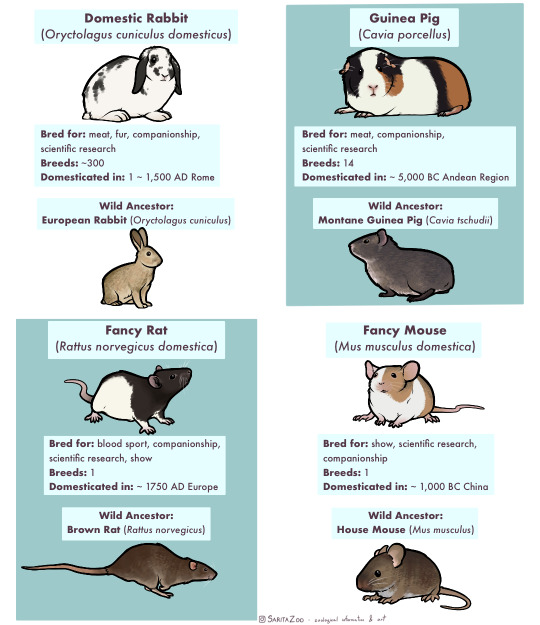
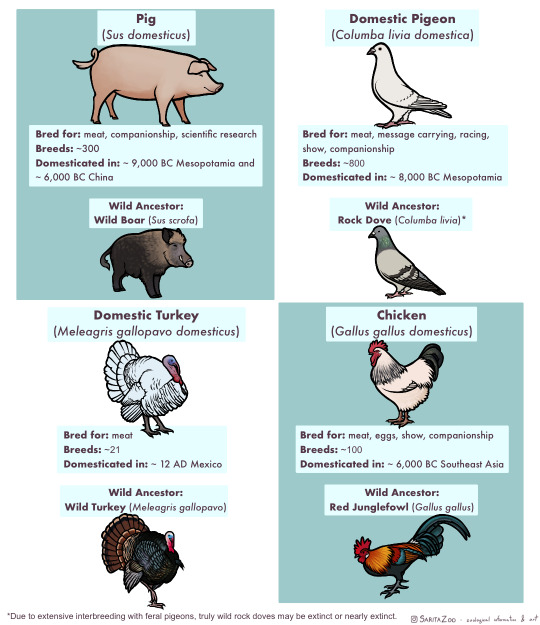
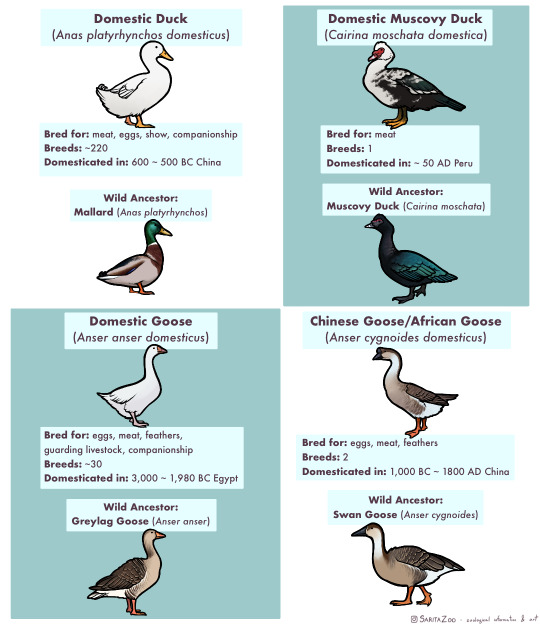
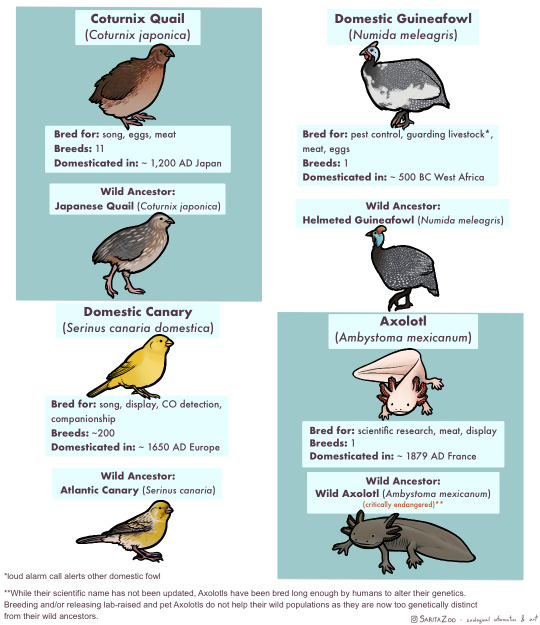
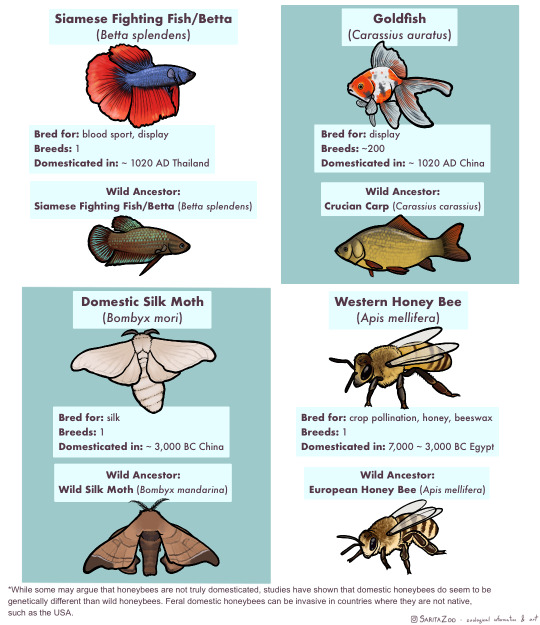

Phew. This one took, uh… a bit longer than expected due to other projects both irl and art-wise, but it’s finally here. The long-awaited domestic animal infographic! Unfortunately, I didn’t have enough space to cover every single domestic animal (I’m so sorry, reindeer and koi, my beloveds) but I tried to include as many of the “major ones” as possible.
I made this chart in response to a lot of the misunderstandings I hear concerning domestic animals, so I hope it’s helpful!
Further information I didn’t have any room to add or expand on:
🐈 “Breed” and “species” are not synonyms! Breeds are specific to domesticated animals. A Bengal Tiger is a species of tiger. A Siamese is a breed of domestic cat.
🐀 Different colors are also not what makes a breed. A breed is determined by having genetics that are unique to that breed. So a “bluenose pitbull” is not a different breed from a “rednose pitbull”, but an American Pitbull Terrier is a different breed from an American Bully! Animals that have been domesticated for longer tend to have more seperate breeds as these differing genetics have had time to develop.
🐕 It takes hundreds of generations for an animal to become domesticated. While the “domesticated fox experiment” had interesting results, there were not enough generations involved for the foxes to become truly domesticated and their differences from wild foxes were more due to epigenetics (heritable traits that do not change the DNA sequence but rather activate or deactivate parts of it; owed to the specific circumstances of its parents’ behavior and environment.)
🐎 Wild animals that are raised in human care are not domesticated, but they can be considered “tamed.” This means that they still have all their wild instincts, but are less inclined to attack or be frightened of humans. A wild animal that lives in the wild but near human settlements and is less afraid of humans is considered “habituated.” Tamed and habituated animals are not any less dangerous than wild animals, and should still be treated with the same respect. Foxes, otters, raccoons, servals, caracals, bush babies, opossums, owls, monkeys, alligators, and other wild animals can be tamed or habituated, but they have not undergone hundreds of generations of domestication, so they are not domesticated animals.
🐄 Also, as seen above, these animals have all been domesticated for a reason, be it food, transport, pest control, or otherwise, at a time when less practical options existed. There is no benefit to domesticating other species in the modern day, so if you’ve got a hankering for keeping a wild animal as a pet, instead try to find the domestic equivalent of that wild animal! There are several dog breeds that look and behave like wolves or foxes, pigeons and chickens can make great pet birds and have hundreds of colorful fancy breeds, rats can be just as intelligent and social as a small monkey (and less expensive and dangerous to boot,) and ferrets are pretty darn close to minks and otters! There’s no need to keep a wolf in a house when our ancestors have already spent 20,000+ years to make them house-compatible.
🐖 This was stated in the infographic, but I feel like I must again reiterate that domestic animals do not belong in the wild, and often become invasive when feral. Their genetics have been specifically altered in such a way that they depend on humans for optimal health. We are their habitat. This is why you only really see feral pigeons in cities, and feral cats around settlements. They are specifically adapted to live with humans, so they stay even when unwanted. However, this does not mean they should live in a way that doesn’t put their health and comfort as a top priority! If we are their world, it is our duty to make it as good as possible. Please research any pet you get before bringing them home!
38K notes
·
View notes
Text
Daisy Fish: The Colorful Gem of Freshwater Aquariums
If you're looking for a peaceful, colorful, and beginner-friendly addition to your freshwater aquarium, the Daisy Fish might just be the perfect choice. Known for its charming colors and calm temperament, this species has been gaining popularity among aquarists around the world.
In this article, we’ll cover everything you need to know about the Daisy Fish—from its origin and care requirements to feeding tips and compatibility with other fish.
🐠 What Is a Daisy Fish?
The Daisy Fish is a common name often used for the Daisy’s Ricefish (Oryzias woworae), a small freshwater fish native to Sulawesi, Indonesia. It’s known for its stunning iridescent blue body, red fins, and peaceful demeanor. Sometimes confused with other ricefish species, the Daisy Fish stands out due to its vibrant coloring and ease of care.
🔍 Why Choose Daisy Fish for Your Aquarium?
✅ Key Benefits:
Eye-catching coloration – Electric blue bodies with red/orange fins
Peaceful nature – Great for community tanks
Small size – Ideal for nano and planted tanks
Easy to care for – Hardy and beginner-friendly
Active schooling behavior – Looks great in groups
These features make the Daisy Fish a favorite among aquarists looking for a low-maintenance yet striking species.
🧬 Origin and Natural Habitat
Daisy Fish are native to the freshwater streams and wetlands of Sulawesi. In the wild, they inhabit slow-moving waters with dense vegetation. This natural environment should be mimicked in home aquariums to keep them healthy and stress-free.
🛠️ Ideal Aquarium Setup for Daisy Fish
ParameterIdeal RangeTank Size10 gallons or largerTemperature72–78°F (22–26°C)pH Level6.5–7.5Water HardnessSoft to moderateLightingModerateSubstrateSand or fine gravel with plants
Tips for Setup:
Add live plants like Java fern or Anubias
Use sponge filters to prevent strong currents
Provide hiding spots with driftwood or rocks
Keep a school of 6 or more Daisy Fish for best results
🍽️ What Do Daisy Fish Eat?
Daisy Fish are omnivorous and enjoy a variety of foods:
Best Food Options:
High-quality micro pellets
Crushed flakes
Live or frozen brine shrimp
Daphnia and microworms
Feed them 1–2 times daily in small amounts. They’re enthusiastic eaters, but overfeeding can lead to poor water quality.
👫 Tank Mates and Compatibility
Daisy Fish are peaceful and do well with other gentle fish. Avoid aggressive or fin-nipping species.
Compatible Tank Mates:
Neon Tetras
Ember Tetras
Corydoras Catfish
Cherry Shrimp
Small Rasboras
Otocinclus Catfish
Avoid:
Bettas (males may become territorial)
Tiger Barbs
Large or aggressive cichlids
🐣 Breeding Daisy Fish
Daisy Fish are egg layers and will breed readily in well-maintained tanks.
Breeding Tips:
Separate a breeding pair or group in a small tank
Use spawning mops or fine-leaved plants
Eggs will appear on plants or tank walls
Remove adults after spawning to protect eggs
Feed fry infusoria or powdered fry food
Within a few days, fry will hatch and begin swimming freely.
🧼 Routine Care and Maintenance
Keeping Daisy Fish healthy involves consistent, simple maintenance:
Weekly water changes of 20–30%
Test water parameters regularly
Clean filters and remove waste
Monitor for illness or signs of stress
With proper care, Daisy Fish can live 3–5 years, making them a long-lasting addition to your aquarium.
⚠️ Common Mistakes to Avoid
Avoid these pitfalls when caring for Daisy Fish:
Keeping them alone or in very small groups (they’re social)
Overfeeding or underfeeding
Skipping water changes
Using strong currents or overly bright lights
Housing with incompatible fish
📦 Where to Buy Daisy Fish
Daisy Fish are increasingly available in the aquarium trade and online.
Where to Find Daisy Fish for Sale:
Specialized aquarium stores
Online tropical fish retailers
Aquarium clubs or local breeders
When looking for Daisy Fish for sale, make sure to choose healthy, active individuals with clear eyes and full fins. Reputable sellers often offer live arrival guarantees and detailed care instructions.
💬 Final Thoughts: Is the Daisy Fish Right for You?
If you're looking for a peaceful, colorful, and beginner-friendly fish, the Daisy Fish is an excellent choice. It’s perfect for planted aquariums, nano tanks, and anyone who wants to create a peaceful aquatic environment.
1 note
·
View note